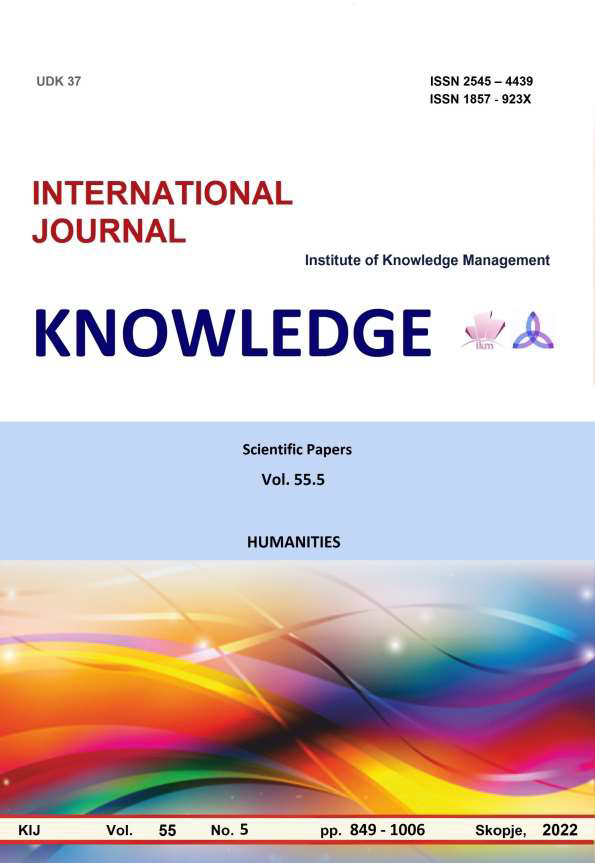THE GREEK KAI BALKAN TRADITION FOCUSING ON THE DUPLE RHYTHMIC FORMATIONS OF “HORA” AND “MAKELARIKO” (KNOWN AS “HASAPOSERVIKO”)
DOI:
https://doi.org/10.35120/kij5505917lKeywords:
Greek santour, Greek tradition, Balkan music, Greek traditional dance “Makelarikos”, Balkan traditional dance “Hora”Abstract
One of the benefits of the folklore revival is the enrichment of information about the folk instruments and
the and dances of the Greek tradition and their evolution both morphologically and musically. Many times, the
definition of the Greek tradition divided intellectual people who tried to detect the basic characteristics that
differentiate the Neo-Greek culture from the cultures of other peoples. Moreover, traditional dances are part of the
spirit of observance, as one of its main means of expression..In this particular study, the aim is to demonstrate the
characteristics of the Greek tradition and the tradition of the Balkan people with the traditional instrument santouri
as a reference point. The santouri plays an important role in the Greek tradition as well as in the tradition of the
Balkans. It is remarkable that it is one of the few instruments where we find variations of the instrument that bring
roots from other countries. Due to the significant influences during the Renaissance period, the study is focused on
the „Hora“ dance and how it was interpreted in the traditions of Greek and Balkan music. The “Hora” is mentioned
to identify a Romanian dance and music genre that shows diversity according to the tempo and the time
signatures.This of course has an influence on Greek traditional dance music where influences from the culture of
other Balkan peoples and Eastern Europe are noticeable, such as "Μakelariko", what we know today as
hasaposerviko.. The research is focused on two main aspects: a) the comparison of the two musical dance genres
"Hora" and "makelariko" (known as hasaposerbiko) and b) is there a difference in the way of performance in the
field of Greek traditional dances and the corresponding Balkan dances of “two beats” time signatures focusing on
the two dances of the study? The method used is qualitative-bibliographic and the sample concerns archival material
related to Greek and Balkan traditional dances. Regarding the santouri, in both Greek and Balkan origin, although
there is not a wide range of literature on the santouri by academic historians who have dealt with the specific
instrument, the bibliographical sources come from important players or from specialized instrument makers.
References
Bartók, B. (2020). Encyclopaedia Britannica, accessed March 11, 2020. https://www.britannica.com/biography/Bela-Bartok.
Bucşan, A. (1971). Specificul Dansului Popular Românesc , Editura Academiei Republicii Socialiste
Drljača, D. (2015). HORA (KOLO) SÂRBO-ROMÂNĂ DIN CARPAŢI ŞI EXTINDEREA EI ÎN DEPĂRTĂRI, Universitatea de Vest din Timişoara
Encyclopedia of Greek Dance (2008). Hasaposervikos or Hasaposervikos, Dance on the Islands and Coasts of the Aegean, source E-E9C07
Gifford, M. P. (2001). The hammered Dulcimer, A HISTORY, Scarecrow Press, Inc
Giurchescu, A. (2001). The New Grove Dictionary of Music and Musicians, in Stanley Sadie (ed.) 29 vols. Macmillian, Vol. 21, London
Giurchescu, A. (1995). Sunni Bloland, Romanian Traditional Dance: A Contextual and Structural Approach, Wild Flower Press, Mill Valley, CA
Kofteros, D. (2019). Dokimio on the Greek Santouri, Philip Nakas
Kofteros, D. (2014). GREEK SANDOURI - HISTORICAL REVIEW. Retrieved from Dimitris V. Kofteros: Dimitris V. Kofteros: santouri (kofterosd.blogspot.com)
Kounadis Archive, "Tatavlian Hasapiko" (2019). Publication source https://vmrebetiko.gr/item?id=4045
Kounadis Archive,“Sirba” (2022). Archive OMEKA Site, accessed November 30,2022, https://kounadisomeka.aegean.gr/items/show/5122
Kokkonis, G. (2017). Folk Music Traditions Word Reading-Folk Achievements,Fagotto
Leontis, A. (2009). Culture and Customs of Greece, Greenwood Press.
Papandrikou, M. (2020). Rhythmo-Melodic Patterns of Modi Performed on the Santouri by Nikos Kalaitzis. Series Musicologica Balkanica. doi:https://doi.org/10.26262/smb.v1i1.7751
Roubis, G. (1999). Greek Dances,General Part-Teaching-Music-kinematic Analysis, Spilias





